Chapter: Digital Signal Processing : IIR Filter Design
IIR Filter Design - Bilinear Transformation Method (BZT)
IIR FILTER DESIGN - BILINEAR
TRANSFORMATION METHOD (BZT)
The
method of filter design by impulse invariance suffers from aliasing. Hence in
order to overcome this drawback Bilinear transformation method is designed. In
analogue domain frequency axis is an infinitely long straight line while
sampled data z plane it is unit circle radius. The bilinear transformation is
the method of squashing the infinite straight analog frequency axis so that it
becomes finite.
Important
Features of Bilinear Transform Method are
2. This
transformation is basically based on a numerical integration techniques used to
simulate an integrator of analog filter.
3. There
is one to one correspondence between continuous time and discrete time
frequency points. Entire range in Ω is mapped only once into the range -∏≤ω≤∏.
4. Frequency
relationship is non-linear. Frequency warping or frequency compression is due to non-linearity. Frequency warping means
amplitude response of digital filter is expanded at the lower frequencies and
compressed at the higher frequencies in comparison of the analog filter.
5. But
the main disadvantage of frequency warping is that it does change the shape of
the desired filter frequency response. In particular, it changes the shape of
the transition bands.
CONVERSION OF ANALOG FILTER INTO DIGITAL FILTER
Z is
represented as rejω in polar form and relationship between Z plane
and S plane in BZT method is given as
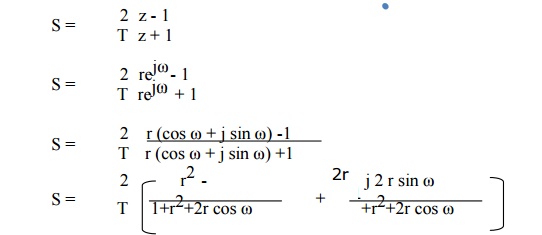
Comparing
the above equation with S= σ + j Ω. We have
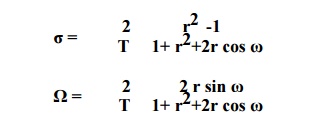
Here we
have three condition
1.
If σ < 0 then 0 < r < 1
2.
If σ > 0 then r > 1
3.
If σ = 0 then r=1
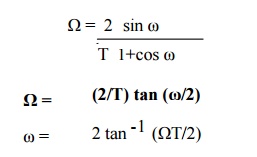
The above
equations shows that in BZT frequency relationship is non-linear. The frequency
relationship is plotted as
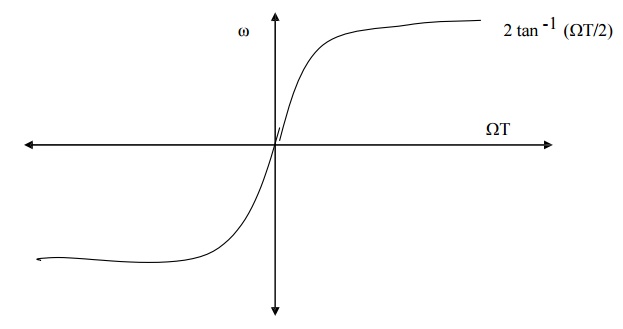
FIG - MAPPING BETWEEN FREQUENCY VARIABLE ω AND Ω IN BZT METHOD.
DIFFERENCE - IMPULSE INVARIANCE Vs BILINEAR
TRANSFORMATION
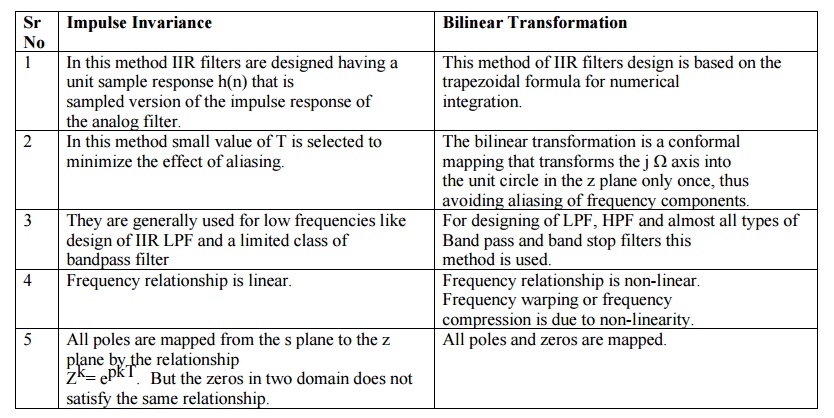
Impulse Invariance
1. In
this method IIR filters are designed having a unit sample response h(n) that is
sampled version of the impulse response of the analog filter.
2. In
this method small value of T is selected to minimize the effect of aliasing.
3. They
are generally used for low frequencies like design of IIR LPF and a limited
class of bandpass filter
4.
Frequency relationship is linear.
5. All
poles are mapped from the s plane to the z
plane by the relationship Zk= epkT. But the zeros in two
domain does not satisfy the same relationship.
Bilinear Transformation
1. This
method of IIR filters design is based on the trapezoidal formula for numerical
integration.
2. The
bilinear transformation is a conformal mapping that transforms the j Ω axis
into the unit circle in the z plane only once, thus avoiding aliasing of
frequency components.
3. For
designing of LPF, HPF and almost all types of Band pass and band stop filters
this method is used.
4.
Frequency relationship is non-linear. Frequency warping or frequency
compression is due to non-linearity.
5. All
poles and zeros are mapped.
LPF AND HPF ANALOG BUTTERWORTH
FILTER TRANSFER FUNCTION

Related Topics